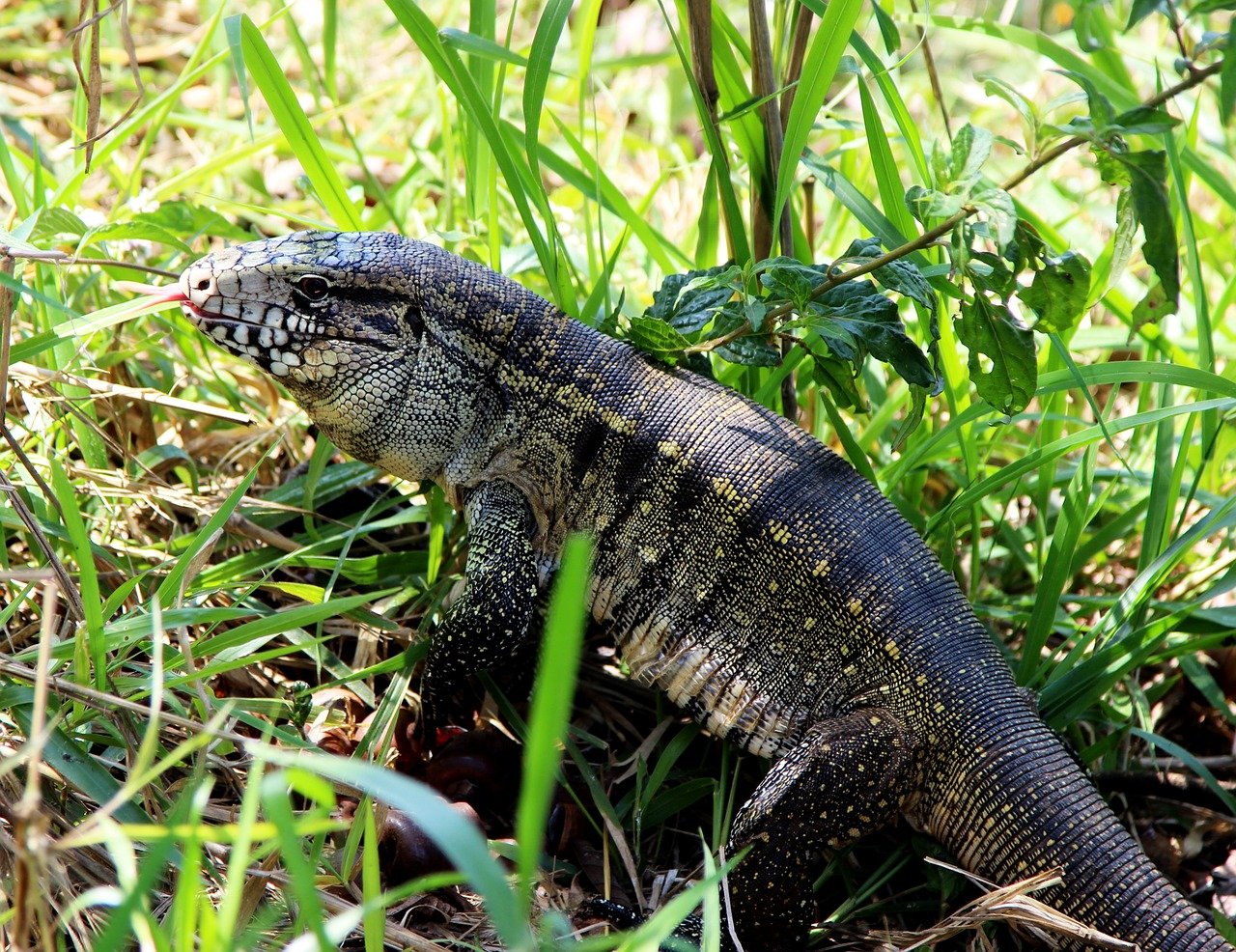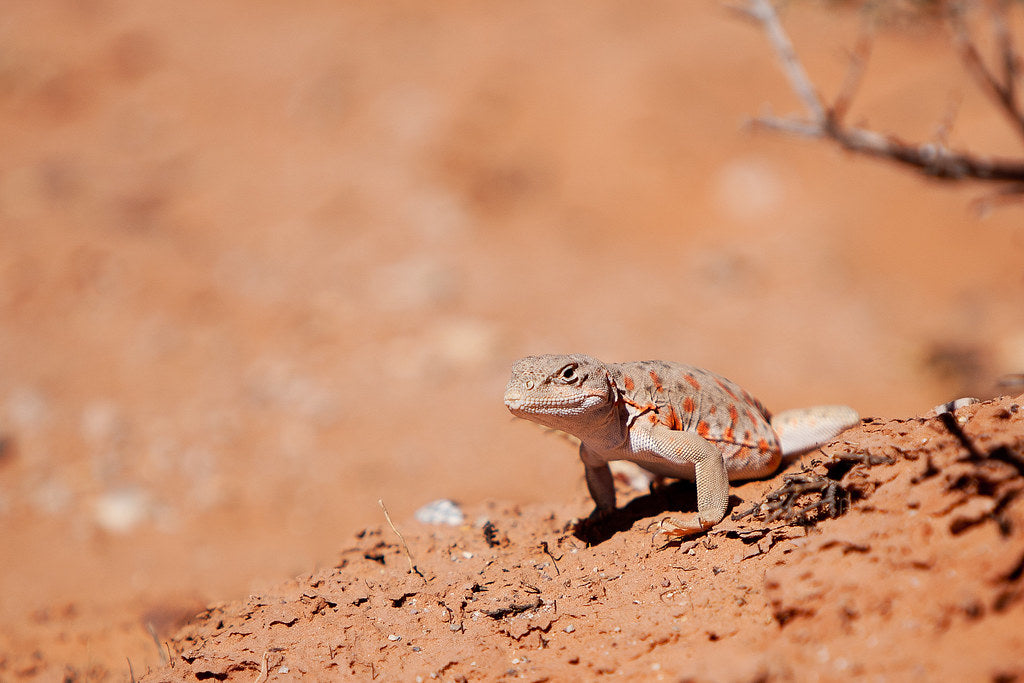Jeweled lacertas (Timon lepidus) are 16-24”, diurnal, semi-arboreal lizards native to southwestern Europe, particularly the Iberian peninsula. They prefer open, dry habitat, and can be found in a variety of areas, including woodland, scrub, rockland, and orchards.
Jeweled lacertas are named for their distinctive coloring: bright green with blue iridescent spots. However, some individuals are duller in color, and more gray or brownish. Males have much larger heads than females.
Jeweled lacertas can be tamed with some effort, and some keepers claim that they can become as tame as a bearded dragon. It’s important to keep in mind, however, that they are very active reptiles and need specialized equipment to stay healthy. They are generally intermediate-level pet reptiles and can live beyond 27 years with good care.
How much space do jeweled lacertas need?
A single jeweled lacerta should be housed in no smaller than a 48”L x 24”W x 24”H enclosure (~120 gallons). However, jeweled lacertas are very active lizards, so if you can provide a larger enclosure, do it!
Cohabitation (housing multiple jeweled lacertas together) is generally not recommended.
Do jeweled lacertas need UVB?
Yes! Jeweled lacertas are diurnal, which means that they are most active during the day, and naturally exposed to lots of sunlight on a day-to-day basis. This means that they need UVB light as part of their enclosure. The best UVB bulbs for a jeweled lacerta housed in a 48” long enclosure are:
If the UVB is mounted over mesh, place the basking area 13-15” below the lamp. If the UVB is mounted inside the enclosure, place the basking area 17-18” below the lamp. The basking area should be the closest surface to the UVB bulb.
The UVB bulb should be housed in a reflective Arcadia or Vivarium Electronics fixture and placed on the basking side along with the heat lamp. Also note that UVB is blocked by glass and plastic, so you can’t give your lizard UVB by placing its terrarium in front of an open window. Make sure that the fixture your UVB bulb is in does not have a clear plastic bulb cover.
In addition to UVB, since jeweled lacertas are day-active lizards, it’s beneficial to provide an additional daylight-spectrum lamp to make sure the enclosure is brightly illuminated. Use a strong 6500K LED or T5 HO fluorescent plant grow light for best results. This may also encourage better coloration from your lizard!
Jeweled lacertas should get 9.5 hours of light per day during winter and 15 hours of light per day during summer. This simulates natural seasonal changes in day length and encourages healthier hormonal rhythms.
What basking temperatures do jeweled lacertas need?
Jeweled lacertas should have a moderate basking temperature around 95°F, with cool side temperatures between 75-85°F. Measure your temperatures with a digital probe thermometer with the probe placed on the desired surface. Heating should be turned off at night.
Provide heat for your jeweled lacerta by imitating the sun with a couple of halogen heat lamps clustered together on one side of the enclosure. Do not use ceramic heat emitters (CHEs), heat mats, red bulbs, or blue bulbs, as these are not as effective. For best results, the basking surface itself should be a large, flat piece of rock.
What humidity levels do jeweled lacertas need?
Jeweled lacertas do best with humidity levels between 35-75%. As long as they have a humid hideout or burrow, though, humidity isn’t something to worry about too much with these lizards. Occasional misting with a pressure sprayer or pouring water is a good way to moisten the substrate and help keep humidity within a healthy range.
What substrate is good for jeweled lacertas?
Substrate covers the floor of your lizard’s terrarium and helps make the enclosure more attractive, but it also helps maintain desired humidity levels and provides something for your lacerta to dig around in.
It’s ideal to use a substrate that imitates the “substrate” that the reptile naturally lives on in the wild. For jeweled lacertas, that means sand or sandy soil. We recommend the following substrates for jeweled lacertas:
- Zoo Med ReptiSand
- Exo Terra Desert Sand
- Play sand
Substrate should be at least 4” deep and completely replaced every 3-4 months. Remove poop and urates daily, along with contaminated substrate.
What décor can you use in a jeweled lacerta terrarium?
Jeweled lacertas are quite intelligent and get bored easily. Using a large enough enclosure is the first step toward preventing this, but it’s also important to provide enrichment to help keep them busy and entertained. It doesn’t matter how big the enclosure is if you don’t put things in it for your pet to use and interact with.
At bare minimum, you will need at least one “cave” for the lacerta to hide in and a flat stone for basking on. However, it’s best to include other items, such as:
- secure stacks of flagstone or aquarium slate
- more hiding places
- ledges
- hollow logs
- branches
- live or artificial plants
- dry shrubs
What do jeweled lacertas eat?
Jeweled lacertas are primarily insectivorous, which means that they need to eat insects (preferably live) in order to get the nutrition that their bodies need. Offer food every morning, as much as they can eat in one day. Juveniles will generally eat more than adults do.
Variety is the key to balanced nutrition, so make sure to offer as many different kinds of bugs as possible!
Feeder insects for jeweled lacertas: dubia roaches, discoid roaches, red runner roaches, crickets, black soldier fly larvae, hornworms, mealworms
Fruit can be occasionally offered as a treat, such as berries, banana, mango, and peaches.
Supplements
You will also need calcium and vitamin supplements to prevent your lacerta from developing a deficiency. We recommend Repashy Calcium Plus LoD, lightly dusted on all of your lizard’s feeder insects.
Water
Although jeweled lacertas are perceived as desert reptiles, they still need access to fresh water. Provide a small water bowl where your lizard can always get a drink when needed. Change the water daily and scrub the bowl with a reptile-safe disinfectant weekly, or whenever it becomes soiled.
Do jeweled lacertas like to be handled?
Few reptiles actually “like” to be held, and although jeweled lacertas can learn to tolerate it, you have to work up to it. Instead of interacting with your lizard by holding it right away, start with hand-feeding with a pair of feeding tweezers.
When you start handling your lacerta, be gentle. Don’t grab the lizard from above, because that will make it afraid of you. Instead, approach from the side and scoop from below. Support as much of its body as possible, especially its feet. Handle inside the enclosure only at first, and let it come to you whenever possible. Start with very short handling sessions in the beginning, then gradually make them longer as your pet becomes more accustomed to you. 10 minutes of interaction daily usually creates a fairly handleable jeweled lacerta. Emphasize positive interactions, and treats can be used as an occasional bribe.
*This care sheet contains only very basic information. Although it’s a good introduction, please do further research with high-quality sources to obtain additional information on caring for this species.
Image credit: Bernard DUPONT from FRANCE - Jewelled Lizard (Timon lepidus) male found under a stone by Jean NICOLAS, CC BY-SA 2.0




Leave a comment
This site is protected by hCaptcha and the hCaptcha Privacy Policy and Terms of Service apply.